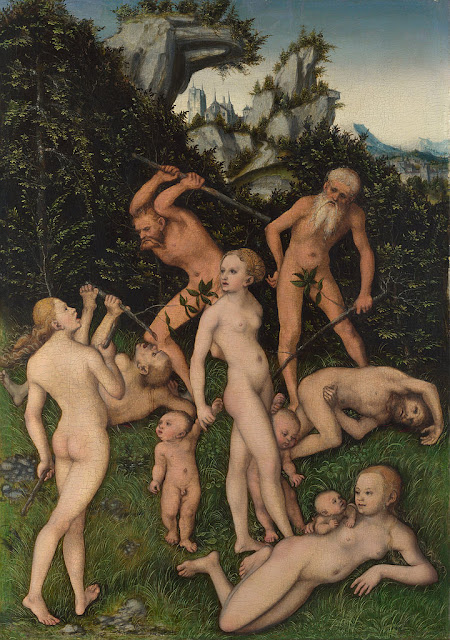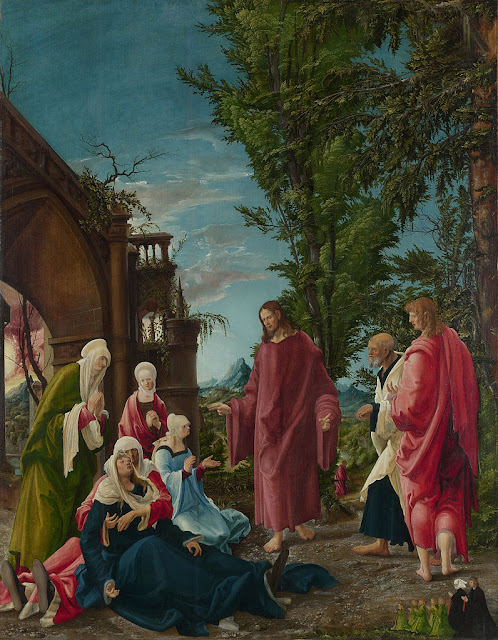 |
| Joachim Patinir Baptism of Christ ca. 1510-20 oil on panel Kunsthistorisches Museum, Vienna |
"Very few facts are known about the life and career of Joachim Patinir. The artist was born in southern Belgium, probably in Bouvignes. His date of birth is unknown; from his appearance in a drawing made in 1521 by Albrecht Dürer, now lost, but engraved by Cornelis Cort and published in 1572, it is thought that he was born around 1485. In 1515 Patinir entered the painters' guild in Antwerp. That Patinir remarried on 5 May 1521 we know from Dürer's diary of his journey to the Netherlands, for the German artist was invited to Patinir's wedding as well as the prenuptial festivities. A document of 5 October 1524 mentions his second wife as a widow."
– from Early Netherlandish Painting by John Oliver Hand and Martha Wolff (Washington: National Gallery of Art, 1986)
 |
| Lucas Cranach the Elder The Three Graces 1535 oil on panel Nelson-Atkins Museum of Art, Kansas City |
 |
| Bernard van Orley Altarpiece of Saints Thomas and Matthias 1519-20 oil on panel Kunsthistorisches Museum, Vienna |
"Bernard van Orley was born in Brussels, probably around 1488. His father Valentin was a painter as was his younger brother Everard, and it is assumed that Bernard was initially taught by his father. . . . Despite his demonstrated ability to assimilate Renaissance architectural and ornamental elements and Italianate figural rhythms into an essentially Netherlandish matrix, it is not known if he ever journeyed to Italy. . . . Van Orley was a skilled draftsman, and in many ways his fame as a creator of a High Renaissance style in the North rests as much upon the tapestries he designed from 1518 onward as upon his paintings. He was also a gifted designer in stained glass. Bernard van Orley died in Brussels on 6 January 1541."
– from Early Netherlandish Painting by John Oliver Hand and Martha Wolff (Washington: National Gallery of Art, 1986)
 |
| Lucas Cranach the Elder Judgment of Paris 1527 oil on panel Statens Museum for Kunst, Copenhagen |
 |
| Bernhard Strigel Emperor Maximilian I with his family ca. 1515 oil on panel Kunsthistorisches Museum, Vienna |
"Bernhard Strigel was born between 1460 and 1461 into a family of artists in Memmingen, a city in the Allgäu region of southern Germany. His grandfather, Hans Strigel the Elder, was a painter and the head of a workshop. . . . In the course of the 1490s Strigel became an independent master in Memmingen and began to produce both religious paintings and portraits. Strigel attracted the attention of Maximilian I and the portrait dated 1504 is one of the earliest of a number portraits of the emperor produced by the artist and his shop. In 1515 Strigel left Memmingen to work in Vienna as court painter to Maximilian. Here, in the same year, he produced one of of the earliest group portraits in Germany, the depiction of Maximilian I and his family."
– from German Paintings of the Fifteenth through Seventeenth Centuries by John Oliver Hand and Sally E. Mansfield (Washington: National Gallery of Art, 1993)
 |
| Lucas Cranach the Elder The Golden Age ca. 1530 oil on panel National Gallery of Norway, Oslo |
 |
| Albert Cornelis Penitent Magdalen in landscape ca. 1510-15 oil on panel National Gallery, London |
"Naturally, clients took it for granted that the master's work was of higher quality than the assistant's, even if the 'identity' of a great artist was not yet an issue. This easily led to potential tension between the interest of the producers or sellers and clients. In early contracts for altarpieces we find already stipulations that the master had to paint it with his own hand and thus without the assistance of his pupils – the first case Liesbeth Helmus records is a contract from 1498. In another contract it is stipulated that the master who received the commission should do the most important parts himself, such as all the naked parts [i.e. faces, hands, etc.] and the most important sections. In 1520 this led to a lawsuit because the painter of an altarpiece, Albert Cornelis, disagreed with his patrons about what this meant. He had done the faces with his own hand, saying that he was obliged to produce only the faces with his own hands, because there lies the most art."
– from Art Market and Connoisseurship by Anna Tummers and Koenraad Jonckheere (Amsterdam University Press, 2008)
 |
| Lucas Cranach the Elder Close of the Silver Age ca. 1530 oil on panel National Gallery, London |
 |
| Albrecht Altdorfer Christ taking leave of his Mother ca. 1520 oil on panel National Gallery, London |
"Albrecht Altdorfer probably trained in a manuscript illuminator's shop, but, as city architect for Regensburg, he also built a slaughterhouse, a wine storage building, and fortifications for the city's walls. . . . Altdorfer's formats ranged from postage-stamp-sized etchings to life-sized paintings. In addition to prints and paintings, he made colored-ground chiaroscuro drawings and designed stained-glass windows. . . . The first landscape painter in the modern sense and the leading figure of the Danube School, Altdorfer introduced landscape as a theme of its own in art. Unlike most of his German contemporaries, he painted few portraits, preferring to focus on the virgin forest or to use it as a setting for both secular and religious subjects. With their gestures, facial expressions, and color distorted for dramatic and emotional ends, his figures complemented his landscapes, themselves alive with an unusual sense of character."
– from curator's notes at the Getty Museum
 |
| Lucas Cranach the Elder Venus with Cupid stealing honey 1530 oil on panel Statens Museum for Kunst, Copenhagen |
 |
| Wolf Huber Christ taking leave of his Mother (fragment) ca. 1520 oil on panel National Gallery, London |
"The most important Danube School painter after Albrecht Altdorfer, Wolf Huber retained a highly individual style throughout his career. His father or uncle might have been a painter, and Huber probably apprenticed in his hometown of Feldkirch, Austria. By 1510 he may have had contact with Altdorfer. . . . Besides religious paintings and numerous half-length and three-quarter-length portraits, Huber designed woodcuts and made landscape drawings. His Danube valley tours produced contemplative views, which often document places he saw and form the backgrounds of his paintings."
– from curator's notes at the Getty Museum
 |
| Lucas Cranach the Elder Salome with the Head of John the Baptist ca. 1530 oil on panel Museum of Fine Arts, Budapest |
 |
| attributed to Jan Provoost Madonna and Child in a landscape before 1529 oil on panel National Gallery, Londom |
"Jan Provoost – born Mons, c. 1465, died Bruges, 1529 – Netherlandish painter, active mainly in Bruges, where he settled in 1494. He was perhaps a pupil of Marmion, whose widow he married soon after the master's death in 1489. His style was fairly close to that of Gerard David, then the leading painter in Bruges, but Provoost, although clumsier, was more inventive. Dürer was his guest when he visited Bruges in 1521."
– from the Oxford Dictionary of Art and Artists (Oxford University Press, 2009)
 |
| Lucas Cranach the Elder St Helena with the True Cross 1525 oil on panel Cincinnati Museum of Art |
"Lucas Cranach was born in 1472 and took his name from his birthplace, the Franconian town of Kronach, which was part of the bishopric of Bamberg. His father, Hans Maler, was an artist and it is assumed that he was Cranach's first teacher. . . . Although the exact date of his appointment is not known, by April 1505 Cranach was employed at the court of Friedrich the Wise, Elector of Saxony, at Wittenberg. The Venetian, Jacopo da' Barbari, was also at court from 1503 to 1505 and his art had a continuing influence. . . . Cranach headed a large workshop that included his sons Hans and Lucas the Younger, as well as numerous apprentices and journeymen. Well in excess of four hundred paintings have been assigned to Cranach and his atelier. . . . Lucas Cranach is probably the artist most closely associated with the Protestant Reformation. He was a friend of Martin Luther who lived and taught in Wittenberg under the protection of the Electors of Saxony. Cranach and his shop produced great numbers of portraits of Luther, his wife, and other Reformers."
– from German Paintings of the Fifteenth through Seventeenth Centuries by John Oliver Hand and Sally E. Mansfield (Washington: National Gallery of Art, 1993)